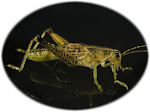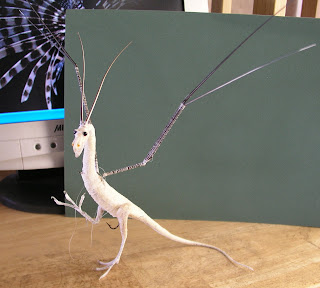I haven't posted anything for quite a while so I thought I'd post something unusual as kind of a new start.
I tyed this fly almost two years ago. Every once in a while it's fun to see how far I can take the techniques and materials. I like to call this type of tying "Beyond Fly Tying" because of the subject matter, the skin of tissue and in this case the wire. Other examples have been the Lionfish and Octopus though wire was not used in them.
The first thing I did was to figure out what to use for nostrils and eye sockets on the head. I decided on cut feather quills for eye sockets and cut porcupine quills for nostrils.
Using mono and thread to shape the jaws, deerhair and thread to shape the head, the glass eyes on wire are tyed in and the porcupine quills lightly wrapped down.
Once I'm sure of the spacing the nostrils are accentuated by sewing through both sides and pulling the threads tight.
The head is being tyed temporarily onto wire. It will be slid off of the wire and tyed onto the body with the mono tags.
The feather quills for eye sockets are added along with the two feather quills for horns.
Everything is then wrapped with thread and a light coat of Fleximent to keep it all in place.
Next the body is tyed up and sized for the head. Mono and light wire is used to make sure it will be free standing and allow me to pose it.
Here you see that I'm starting to assemble the separate parts. The head has been tyed on, the toes have been built up and claws added and a length of wire run through the body to slide the wing quills onto.
The wing spars are stripped pigeon quills tyed together with mono for strength. The extra thread extending from the bases of the quills will be sewn into the body to attach the wings and body together.
Here you can see I've added some muscles with deer hair. More work has been done to the feet, head and belly scales have been added.
The wing spars are shown being shaped as bone and tissue with bat like fingers added to the wing joints. The tongue has been added.



























